1997 TOYOTA T100 ECU
[x] Cancel search: ECUPage 148 of 212
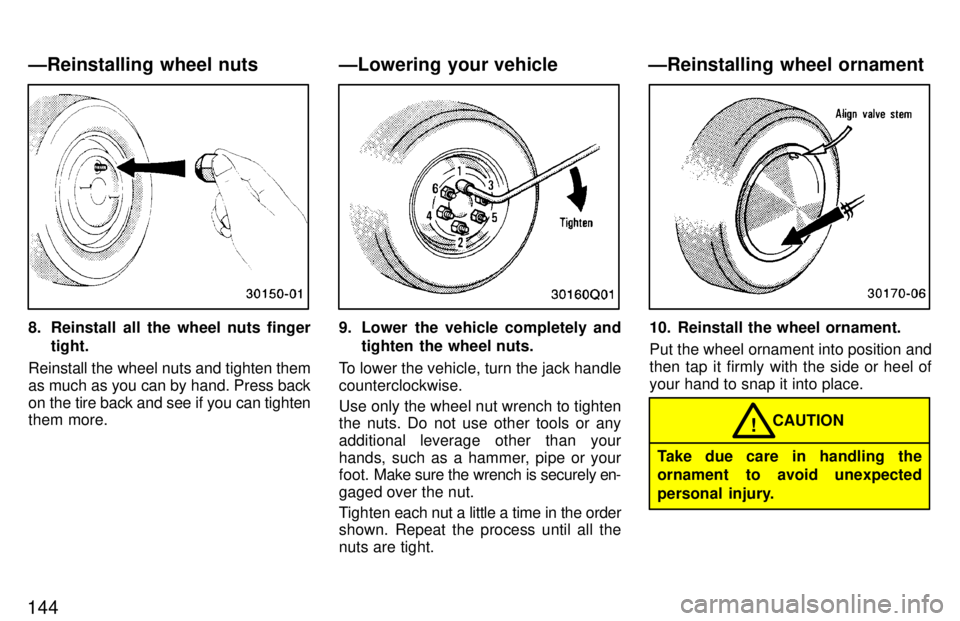
144
8. Reinstall all the wheel nuts fingertight.
Reinstall the wheel nuts and tighten them
as much as you can by hand. Press back
on the tire back and see if you can tighten
them more.9. Lower the vehicle completely and
tighten the wheel nuts.
To lower the vehicle, turn the jack handle counterclockwise. Use only the wheel nut wrench to tighten the nuts. Do not use other tools or any
additional leverage other than your
hands, such as a hammer, pipe or your
foot. M ake sure the wrench is securely en-
gaged over the nut.
Tighten each nut a little a time in the order
shown. Repeat the process until all the
nuts are tight.10. Reinstall the wheel ornament.
Put the wheel ornament into position and
then tap it firmly with the side or heel ofyour hand to snap it into place.
Take due care in handling the
ornament to avoid unexpected
personal injury. CAUTION
!
ÐLowering your vehicle ÐReinstalling wheel ornament
ÐReinstalling wheel nuts
Page 149 of 212
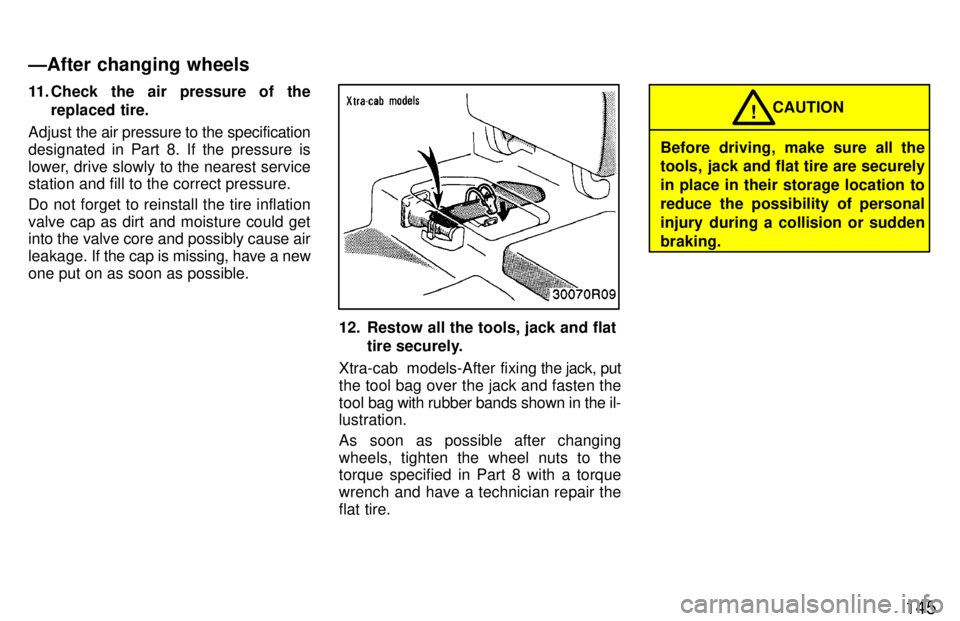
145
11. Check the air pressure of the
replaced tire.
Adjust the air pressure to the specification
designated in Part 8. If the pressure is
lower, drive slowly to the nearest service station and fill to the correct pressure.
Do not forget to reinstall the tire inflation valve cap as dirt and moisture could get into the valve core and possibly cause air
leakage. If the cap is missing, have a new
one put on as soon as possible.
12. Restow all the tools, jack and flat
tire securely.
Xtra-cab models-After fixing the jack, put
the tool bag over the jack and fasten the tool bag with rubber bands shown in the il-
lustration.
As soon as possible after changing
wheels, tighten the wheel nuts to the torque specified in Part 8 with a torque
wrench and have a technician repair the
flat tire.
Before driving, make sure all the
tools, jack and flat tire are securely in place in their storage location to
reduce the possibility of personal
injury during a collision or suddenbraking. CAUTION
!
ÐAfter changing wheels
Page 153 of 212
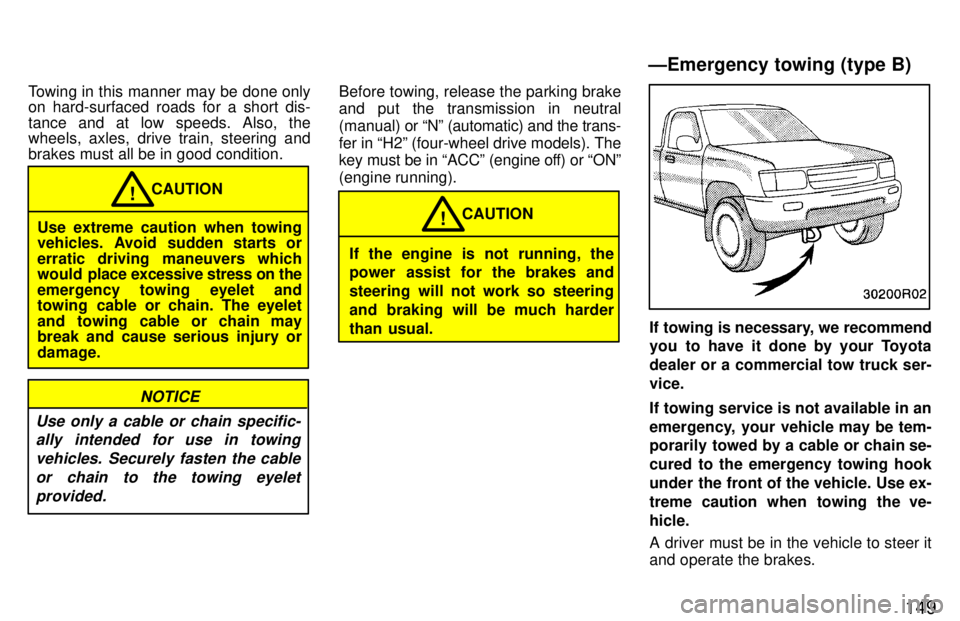
149
Towing in this manner may be done only
on hard-surfaced roads for a short dis-
tance and at low speeds. Also, the
wheels, axles, drive train, steering and brakes must all be in good condition.
CAUTION!
Use extreme caution when towing
vehicles. Avoid sudden starts or
erratic driving maneuvers which
would place excessive stress on the
emergency towing eyelet and
towing cable or chain. The eyelet
and towing cable or chain may break and cause serious injury or damage.
NOTICE
Use only a cable or chain specific- ally intended for use in towing
vehicles. Securely fasten the cableor chain to the towing eyelet provided.
Before towing, release the parking brake
and put the transmission in neutral
(manual) or Nº (automatic) and the trans-
fer in H2º (four-wheel drive models). The
key must be in ACCº (engine off) or ONº
(engine running).
CAUTION!
If the engine is not running, the
power assist for the brakes and
steering will not work so steering
and braking will be much harder
than usual.
If towing is necessary, we recommend
you to have it done by your Toyota
dealer or a commercial tow truck ser-vice.
If towing service is not available in an
emergency, your vehicle may be tem-
porarily towed by a cable or chain se-
cured to the emergency towing hook
under the front of the vehicle. Use ex-
treme caution when towing the ve-hicle.
A driver must be in the vehicle to steer it and operate the brakes.
ÐEmergency towing (type B)
Page 154 of 212
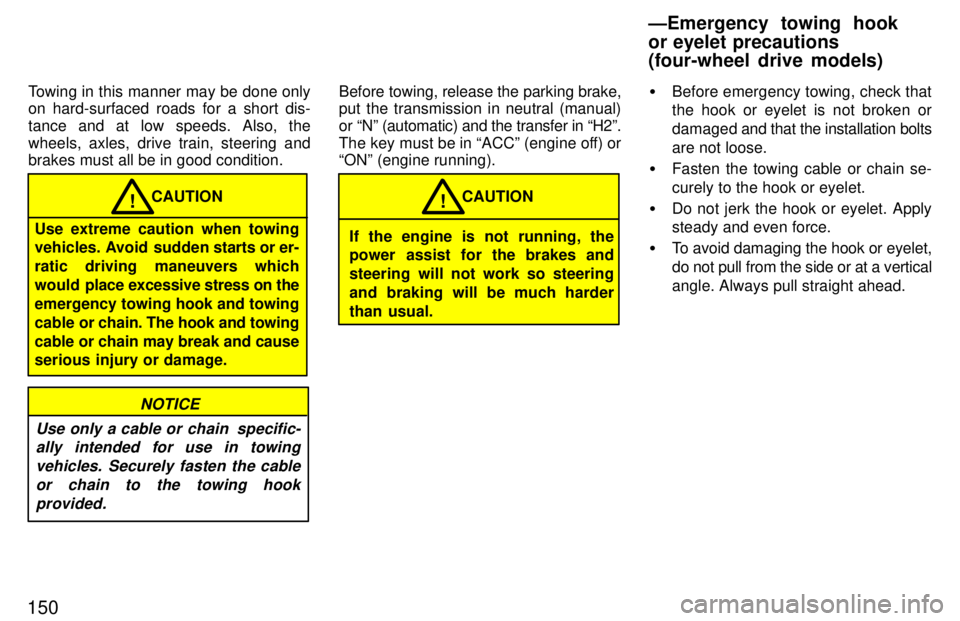
150Towing in this manner may be done only
on hard-surfaced roads for a short dis-
tance and at low speeds. Also, the
wheels, axles, drive train, steering and brakes must all be in good condition.
CAUTION!
Use extreme caution when towing
vehicles. Avoid sudden starts or er- ratic driving maneuvers which
would place excessive stress on the
emergency towing hook and towing
cable or chain. The hook and towing
cable or chain may break and cause
serious injury or damage.
NOTICE
Use only a cable or chain specific- ally intended for use in towing
vehicles. Securely fasten the cableor chain to the towing hook provided.
Before towing, release the parking brake, put the transmission in neutral (manual)
or Nº (automatic) and the transfer in H2º.
The key must be in ACCº (engine off) or ONº (engine running).
CAUTION!
If the engine is not running, the
power assist for the brakes and
steering will not work so steering
and braking will be much harder
than usual. �
Before emergency towing, check that the hook or eyelet is not broken or
damaged and that the installation bolts
are not loose.
� Fasten the towing cable or chain se-curely to the hook or eyelet.
� Do not jerk the hook or eyelet. Apply
steady and even force.
� To avoid damaging the hook or eyelet, do not pull from the side or at a vertical
angle. Always pull straight ahead.
ÐEmergency towing hookor eyelet precautions (four-wheel drive models)
Page 163 of 212

159
Tire surface and wheel nuts Check the tires carefully
for cuts, damage
or excessive wear. See Chapter 7-2 for
additional information. When checking the tires, make sure no nuts are missing,
and check the nuts for looseness. T ighten
them if necessary.
Tire rotation
Rotate the tires every 12000 km (7500
miles). See Chapter 7-2 for additional in- formation.
Fluid leaks Check underneath for leaking fuel, oil, wa-
ter or other fluid after the vehicle has been
parked for a while. If you smell fuel fumes
or notice any leak, have the cause found
and corrected immediately. Doors and engine hood Check that all doors including tailgate op- erate smoothly and all latches lock se-
curely. M ake sure the engine hood secon-
dary latch secures the hood from opening
when the primary latch is released. INSIDE THE VEHICLE Items listed below should be checked
regularly, e.g. while performing peri-
odic services, cleaning the vehicle,etc. LightsMake sure the headlights, stop lights, tail lights, turn signal lights, and other lights are all working. Check headlight aim. Service reminder indicators and
warn-
ing buzzersCheck that all service reminder indicators
and warning buzzers function properly. Steering wheel
Be alert for changes in steering condition, such as hard steering or strange noise. Seats Check that all seat controls such as seat
adjusters, seatback recliner, etc. operate
smoothly and that all latches lock securely
in any position. Check that the head re-
straints move up and down smoothly and
that the locks hold securely in any latched
position. For folding-down seatback
(bench seat), check that the latches lock
securely. Seat belts
Check that the seat belt system such as
buckles, retractors and anchors operate
properly and smoothly. Make sure that the
belt webbing is not cut, frayed, worn ordamaged.
Accelerator pedal Check the pedal for smooth operation and
uneven pedal effort or catching. Clutch pedal Check the pedal for smooth operation. Brake pedal Check
the pedal for smooth operation and
that the pedal has the proper clearance. Check the brake booster function. Brakes
At a safe place, check that the brakes do not pull to one side when applied. Parking brake Check that the lever has the proper travel and that, on a safe incline, your vehicle is
held securely with only the parking brake applied.
Automatic transmission Parkº mech-
anism
On a safe incline, check that your vehicle is held securely with the selector lever in Pº position and all brakes released.
IN THE ENGINE COMPARTMENT Items listed below should be checked
from time to time, e.g. each time when refueling.
Washer fluid
Make sure there is sufficient fluid in the
tank. See Chapter 7-3 for additional infor-
mation.
Page 188 of 212
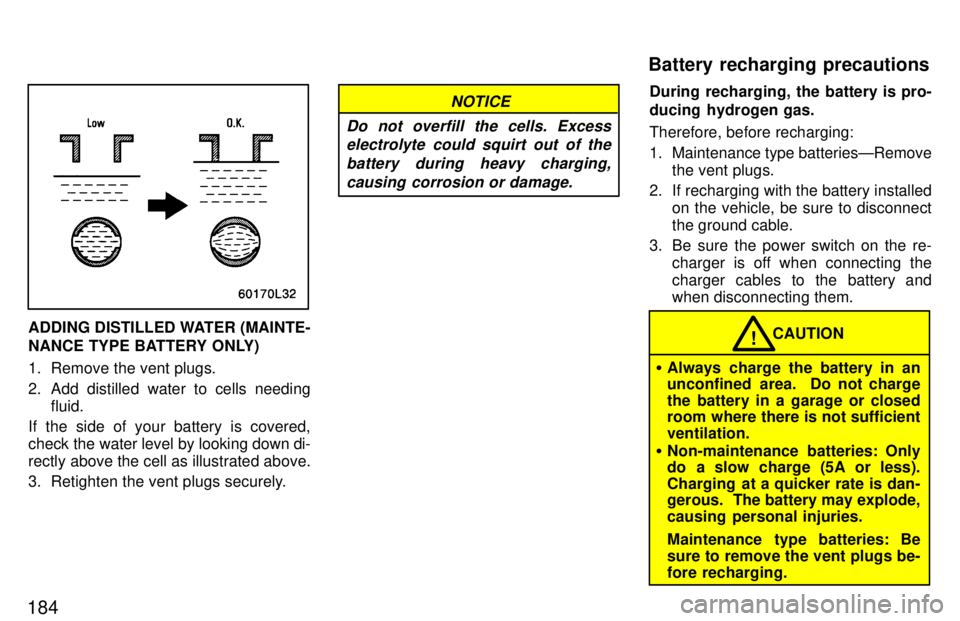
184
ADDING DISTILLED WATER (MAINTE-
NANCE TYPE BATTERY ONLY)
1. Remove the vent plugs.
2. Add distilled water to cells needingfluid.
If the side of your battery is covered,
check the water level by looking down di-
rectly above the cell as illustrated above.
3. Retighten the vent plugs securely.
NOTICE
Do not overfill the cells. Excess electrolyte could squirt out of the
battery during heavy charging,causing corrosion or damage.During recharging, the battery is pro-
ducing hydrogen gas. Therefore, before recharging:
1. Maintenance type batteriesÐRemove the vent plugs.
2. If recharging with the battery installed on the vehicle, be sure to disconnect the ground cable.
3. Be sure the power switch on the re- charger is off when connecting the
charger cables to the battery and
when disconnecting them.
�Always charge the battery in an
unconfined area. Do not charge
the battery in a garage or closed
room where there is not sufficient ventilation.
� Non-maintenance batteries: Only
do a slow charge (5A or less).
Charging at a quicker rate is dan-
gerous. The battery may explode,
causing personal injuries.
Maintenance type batteries: Be sure to remove the vent plugs be-fore recharging. CAUTION
!
Battery recharging precautions
Page 205 of 212

201
17. RADIO 7.5 A: Radio, cassette tape
player, power antenna, power rear
view mirrors
18. CIG. 15 A: Cigarette lighter, digital
clock display, shift lick control system(automatic transmission)
19. TURN 10 A: Turn signal lights, emer-
gency flashers
20. ECU-B 15 A: Anti-lock brake system,
SRS airbag system, cruise control
system, daytime running light system
21. DRL 7.5 A: Daytime running light sys-
tem
22. ECU-IG 20 A: Anti-lock brake sys-
tem, cruise control system 23. OBD 2 7.5 A:
On-board diagnosis
system
Fuses (type B)
24.AM1 40 A: Starting system, all compo-
nents in ENGINEº, IGNº, WIPERº,
GAUGESº. RADIOº, CIG.º, TURNº
and PWRº fuses
25. AM2 340 A: Starting system, all com-
ponents in ENGINEº, IGN.º, WIP-
ERº, GAUGESº, RADIOº, CIG.º and
TURNº fuses
26 HEATER 40 A: Air conditioning heat-
ing system
27. PWR 30 A: Power door lock system,
power windows
Fuse (type C)
28. ABS 60 A: Anti-lock brake system
29. ALT 100 A: All components in A/Cº,
TAILº, STOPº, ECU-Bº, AM1º and
HEATERº fuses
Page 210 of 212
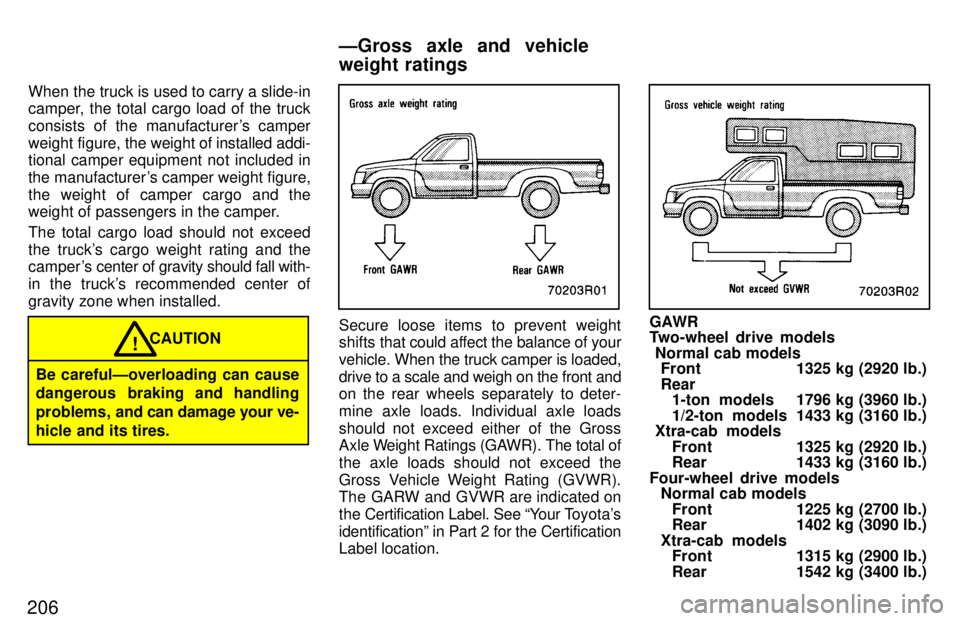
206When the truck is used to carry a slide-in
camper, the total cargo load of the truck
consists of the manufacturer's camper
weight figure,
the weight of installed addi-
tional camper equipment not included in
the manufacturer's camper weight figure,
the weight of camper cargo and the
weight of passengers in the camper.
The total cargo load should not exceed
the truck's cargo weight rating and the
camper 's center of gravity should fall with-
in the truck's recommended center of
gravity zone when installed.
CAUTION
Be carefulÐoverloading can cause
dangerous braking and handling
problems, and can damage your ve-
hicle and its tires.!
Secure loose items to prevent weight
shifts that could affect the balance of your
vehicle. When the truck camper is loaded, drive to a scale and weigh on the front and
on the rear wheels separately to deter-
mine axle loads. Individual axle loads
should not exceed either of the Gross
Axle Weight Rati ngs (GAWR). The total of
the axle loads should not exceed the
Gross Vehicle Weight Rating (GVWR).
The GARW and GVWR are indicated on
the Certification Label. See Your T oyota's
identificationº in Part 2 for the Certification
Label location.GAWR
Two-wheel drive models Normal cab modelsFront 1325 kg (2920 lb.) Rear 1-ton models 1796 kg (3960 lb.)
1/2-ton models 1433 kg (3160 lb.)
Xtra-cab models
Front 1325 kg (2920 lb.)
Rear 1433 kg (3160 lb.)
Four-wheel drive models Normal cab models
Front 1225 kg (2700 lb.)
Rear 1402 kg (3090 lb.)
Xtra-cab models Front 1315 kg (2900 lb.)
Rear 1542 kg (3400 lb.)
ÐGross axle and vehicle
weight ratings